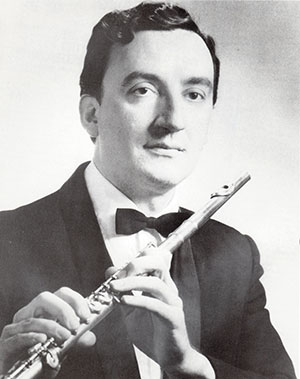Anyone who knows Thomas Nyfenger, professor of music at Yale University, is immediately impressed by his ability to magically imitate the sounds of other flutists. Nyfenger will say, "This is Rampal; this is Baker;" and so on. At one of his annual summer master classes, an Indian flutist demonstrated how different his music was from traditional Western flute music. The visitor played glissandi, unusual quarter-tone melodies, and all the things that "can’t be done" on the modern flute. Nyfenger took this on as a challenge and came to class the following day sounding just like his Indian guest – glissandi, quarter tones, and all.
As a musician Nyfenger thinks through pieces on an extraordinarily high level. Julia Bogorad, principal flutist of the St. Paul Chamber Orchestra and former Nyfenger student, recalls an experience shared by all who study with him. After hearing her play a Jeanjean etude, he remarked, "It sounds as though you are hearing the harmony this way," at which point he quickly improvised an accompaniment at the piano. Then he said, "Perhaps you would like this better," and a luscious, elaborate Wagnerian sound emerged.
As students, many of us have experienced that sinking feeling of having forgotten to bring the piano part to a lesson. Nyfenger offers his own solution to this predicament. "If he hasn’t memorized the piano part in question," says Mary Posses (Kansas City Conservatory), who studied with Nyfenger for six years, "he will improvise something that works."
 Well-Rounded Musician
Well-Rounded Musician
Nyfenger’s knowledge of Baroque music is as equally thorough as it is of orchestral excerpts and the latest 20th-century music. Heidi Ruby (recent fourth prize winner of the Munich competition and second flute in the Columbus Symphony) refers to her study of the Telemann Twelve Methodical Sonatas as the highlight of her work with Nyfenger. Like most everyone, she was astounded by Nyfenger’s ability to ornament Baroque music from a knowledgable and creative basis. "Not only that, he can also improvise his own figured-bass accompaniment." When coaching students on orchestral excerpts and woodwind quintets (he has been a member of the New York Woodwind Quintet and several orchestras), Nyfenger always stresses the importance of knowing the whole score. As a living testament to his advice he frequently plays, say, the clarinet part on his flute – and not just the notes. You may believe you are actually hearing a clarinet!
Exposure to such talent challenges the student to grow, but so does Nyfenger’s ability as a teacher. He is able to analyze quickly the weaknesses and needs of the student – whether it be technique, sound production, or even emotional needs. It may take him seven words to say what may take another teacher an hour. Peter Standaart, who has organized several master classes for Nyfenger, says, "The master class situation brings out the performer in him. He comes to life, as if he is on stage, and is always listening and considering what is best for the student." Along with the serious learning that takes place, there is a constant whirlwind of puns that fly by almost as fast as some of the notes.
Nyfenger has this to say about his masterclasses:
There is a cross section of levels of accomplishment, attitudes, problems, beautiful things to share, and a built-in audience, the most critical, yet most sympathetic in the world. To get in front of these people and be a big ham, to accompany them, encourage them, chide them, share in the agony of their problems and the glory of their sucesses, to watch people help one another and learn from all these fine living examples: to me this is what teaching and learning are all about.
An Incredible Sound
One of the best things about studying with Nyfenger is just to hear him play. Karen Yonovitz (University of Colorado, Boulder) says, "I’m still trying to attain the color and variety of his unique sound." Sandford [Sandy] Drelinger, who holds a unique perspective as a head-joint maker, pinpoints an "extraordinary property" of Nyfenger’s playing. He says that, whereas the French school is "wildly sensitive to timbre, the American school is equally sensitive to pitch. Tom Nyfenger is both; and with him it is intuitive, not cerebral."
Nyfenger’s sound is effortless, hauntingly dark, and always expressive and adaptable to the music. Nyfenger is so sensitive to timbre, he may play different flutes during the same concert to help project the sound he believes the composer intended. In a recent concert he used his old French flute for both a Leclair sonata and Debussy’s Syrinx; his platinum flute for Density 21.5, and his gold flute for Romantic music.
Changing from one flute to another is not just determined by timbral considerations. Articulation is another important factor. Nyfenger says, "My old French flute is the most clear and easy to articulate," thus reinforcing the particular demands of the music of Leclair. He has many insights about articulation which he shares with his students either through demonstration, exercises, or perceptively listening to a variety of flutists on records, one of his favorite pastimes shared with students. Following here is a conversation with Thomas Nyfenger.
When did you start playing the flute?
I began playing at age 13 without any instruction, then started my first lessons at age 17. My first instrument, however, was piano, which I began studying formally at age nine. When I was finishing high school I knew I was going to be a flutist. Maurice Sharp was my principal teacher, and I was also helped a lot by Robert Willoughby and William Herbert [piccoloist with the Cleveland Orchestra]. Still, many of my best teachers I’ve never paid. They contributed to my learning through the left ear while I sat second to them in orchestras.
How have you developed such a keen ear?
By listening critically to everything from age zero. My father played the piano by ear, in F# exclusively and cross-handed, and my mother sang. I imitated them, and listened to the radio in the stone age preceding television. I learned to play by ear and play things back on the piano. Improvising also seems to have helped.
Do you think flutists should play a second instrument?
Everyone should learn to play the piano before any other instrument. It is the measuring stick, the graphic example, of how to hear intervals and harmony. I also played doublebass, and tried the bassoon and horn. I feel this experience has given me an understanding of other instruments, and is definitely an aid to me in coaching mixed groups.
You have always stressed the importance of knowing the whole piece, not just the flute part. Why is this so important?
When someone plays for me, with or without the accompaniment, I know whether they know the entire score. If he sounds like someone reading just his own lines from a play in which all the other lines have been deleted, then the lack of context will cause him to offer a shallow interpretation. Whereas harmonic inflection, contrapuntal interplay, and rhythmic interaction – all these are derived from a knowledge of the whole piece. Who wants to be manning one operation on an assembly line?
How do you perceive your function as a teacher?
My function is to teach people how to think, how to work, how to accelerate their progress in a shorter time than were they left alone. Eventually, they can build beyond today’s standards.
What qualities do you encourage most in your students?
I encourage their right to develop, express, and share something beautiful, to be unique, though well-grounded and respectful of styles and differences of interpretation. Also, I encourage hard work and careful evaluation of what is coming out of the flute.
How do you motivate students?
I am afraid I have little energy or desire to motivate students in any way, except by offering examples, giving them my "permission" to play expressively and beautifully, and by helping them to be themselves. When I try to spoonfeed students by marking every nuance and demanding they be clones of myself, I feel as bad as when conductors try to do that to me.
Can you comment on the quality of students you have taught in the last 20 years?
I feel very fortunate in having worked with so many excellent students. The level of playing has obviously risen dramatically over the years, because examples via recordings and fine teachers have given people better and better head starts. At any given time, I have a couple of students who can play rings around me technically. I am pleased by this, and also just frustrated enough to try harder. I may control most of the lesson, but when the student offers something of interest, I will remember it, and thus learn myself.
What qualities distinguish an outstanding student from the others?
A fine ear, a sense of meter (which is more advanced than just having good rhythm), the ability to produce interesting tonal colors and to play rubato without extending the chronological debt; also total dedication and commitment, a hunger-in-the-gut to be outstanding.
What sorts of careers are your students now pursuing?
My students are playing in orchestras; teaching at universities, conservatories, and neighborhood schools; free-lancing, and even pursuing successful careers as soloists. Some play excellent jazz; some start chamber groups; some play for fun and sell stocks and live in splendor. One of my Yale senior classes, which was comprised of several excellent flutists, now consists of three soon-to-be doctors and one journalist. I believe they will always love music and continue to play, and will be, in my estimation, more humane operators than most.
Do you have any advice to up-and-coming high school flutists? What can they do to best prepare themselves for a career in music?
Get a good teacher. Listen a lot, and figure out [listen critically) to what they are hearing.
Many folks comment on the uniqueness of your sound. How do you achieve so many tonal colors?
Very early on in my studies I would take an admired recording and listen to it many times, then retire to an upstairs bathroom and practice in front of the mirror, trying to figure out how this sound was produced. After studying many different flutists, I found myself to be a compendium of many different styles and sounds. I consider this to be learning, not copying.
You have a tremendous command of Baroque ornamentation. How did you learn it, and how do you teach it?
Treatises on the subject are quite useful, but Telemann’s living examples in the Twelve Methodical Sonatas, combined with listening to experts and experimenting under the guidance of good teachers, seem most beneficial. Think of how jazz players learn to improvise, but with different parameters. Fortunately, I have been privileged to perform with excellent ornamentors like Ronald Roseman and Henry Schuman, oboists, and Kenneth Cooper and Britt Wheeler, harpsichordists, and to study the Telemann sonatas with Samuel Baron.
You also feel equally at home with 20th century music. Is the embouchure affected from playing experimental techniques?
Most 20th century music calls for techniques that are extensions of known [common] techniques. Whistle tones should relax the lips, and bending pitches should be practiced with a return to a neutral position. I consider multiphonics a weak perversion, a lets-do-it-because-it’s-possible technique; but they don’t hurt us. If done correctly, most avant-garde techniques can actually improve the execution of standard ones. Only sadistic practices, such as extended buzzing, endless pppp on D7, and required ugliness can wear one down.
Some flutists hardly vary their vibrato from one piece to the next. What is your concept of the role of vibrato?
Vibrato should not be a constant, as on the electronic organ, but a color. I often practice a piece like a clarinetist, without vibrato, to force myself to work out interesting phrasing. Technically, combinations of speed and depth of vibrato are employed. Once the piece is understood in terms of harmonic and rhythmic inflections, vibrato quite naturally comes in to color appoggiaturas, help phrases to grow, etc.
There is a revolution going on in the flute industry. Flutists appear to be searching high and low for the perfect equipment. What is your opinion about flutists changing head joints?
"Head-hunters" are a relatively new breed. Some even carve their own blow-holes, and many heads are discarded just as less-expensive reeds have been for centuries. One of the problems inherent in this activity is a lack of satisfaction due largely to a lack of familiarity with any one head. A fine player once told me, "Flutes are like women; if you find a good one, you only need one." Another trend is toward the easiest, most secure equipment, which often means a shallow, bright, east-to-play head joint. On the positive side, individual makers, such as Sandy Drelinger, offer an assortment of heads and take the time to advise you personally.
You once said there were no out-of-tune-flutes, only out-of-tune flutists. What do you mean by this statement?
Verne Q. Powell, the great flute maker, first answered me thus when I inquired about the out-of-tune- notes on the flute. I thought him either defensive or eccentric until Albert Tipton said; "Find the way to blow which causes the best intonation, and you will have the best tone." Finally, I watched Julius Baker play with a gorgeous, even tone and remain in tune without all kinds of head nodding or jutting-out of the jaw, or lip tricks. In adding all these clues up, I began to find the correct angle at which all notes can be played with only airspeed changes; the result was an improvement in pitch.
What do you think about when you are performing?
Sometimes, when I am very well prepared, I can let the technical things happen automatically and think, as one great performer said, "of a beer and corned-beef sandwich." The audience becomes warm and caring, and I am an actor singer, not someone pushing buttons on an oversophisticated piece of plumbing.
Anyone who knows you quickly learns your stand for punctuality in arriving on time for lessons and rehearsals. Why is this important in preparing for a career?
A former student asked me for a recommendation to a fine New York orchestra, and he got the job. He arrived quite late for the first rehearsal, as he was in the habit of doing while in school. He was fired. I, myself, was not asked to play there for some time, and accept the responsibilty for having made a bad recommendation. No one can be late for a recording, which may be costing hundreds of dollars a minute.
I remember when George Szell took over the directorship of the Cleveland Orchestra. One hundred musicians would be on stage for a concert nervously waiting an extra 10 minutes for a few stragglers in the audience to parade in and display their finery. The Maestro got tired of this and instructed the ushers to close the doors at 8:30, causing a lot of "but I’m Or. So-and-so’s wife … " disbelief; but it worked. The audience members were retrained, and also listened with reverence and respect to him who had offered them the spanking they had missed as children.
What is the importance of music in our world today?
I believe we have forgotten why we strive to achieve wealth and status, as most who have them have little else but the desire for more money and power. Greed seems to motivate most of the ills of the world. If music can offer something beautiful to cherish, we may cherish life all the more. If I can make a small crack in someone’s receptive soul, perhaps the world will be just a tiny bit better off. To speak without words, to transcend the commonplace – that is the importance of music.






